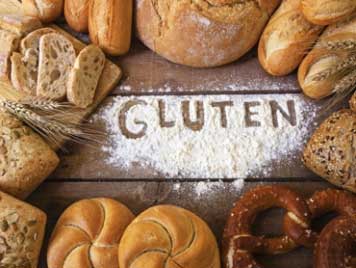Goodbye Gluten
For those living with celiac disease or food allergies, adhering to a strict diet is both challenging and essential.
More than 2 million people in the United States have celiac disease, or about 1 in 133 people, according to The National Institute of Diabetes and Digestive and Kidney Diseases (NIDDK). The Celiac Disease Foundation describes celiac disease as an autoimmune disorder in which the ingestion of gluten leads to damage in the small intestine.
Similarly, 15 million Americans, including one in 13 children, are affected by food allergies, according to Food Allergy Research & Education (FARE). An allergic reaction to food can range from mild to severe; can affect the skin, gastrointestinal tract, respiratory tract or cardiovascular system; and can include potentially life-threatening anaphylaxis. In the United States, food allergy symptoms send someone to the emergency room every three minutes.
Living with Food Allergies
A food allergy results when the immune system mistakenly targets a food protein as a threat and attacks it. Although nearly any food is capable of causing an allergic reaction, only eight foods account for 90 percent of all food allergic reactions in the United States. These foods are peanuts, tree nuts, milk, egg, wheat and soy, according to FARE.
It is believed that celiac disease is triggered by the gliadin component of gluten, says Benjamin Kaplan, M.D., who specializes in internal medicine at Orlando Health. Classic symptoms include diarrhea, steatorrhea, weight loss, and nutrient or vitamin deficiencies, although many patients present with atypical or no symptoms at all, says Dr. Kaplan, who advises seeking treatment as soon as possible.
Untreated celiac disease can lead to a variety of health issues including micronutrient deficiencies, bone loss, certain cancers, type 1 diabetes mellitus, connective tissue diseases, Hashimoto’s thyroiditis, and Graves’ disease, he says.
“The best treatment for celiac disease is to stop eating gluten completely,” Dr. Kaplan says. “This might be hard to do at first. You will need to avoid rye, wheat, barley, and maybe oats.” Gluten can be found in many common foods including bread, pasta, pastries, cereal, many sauces, spreads, condiments, beers, ales, lagers and malt vinegars.
“Most people usually feel a lot better within two weeks of starting a gluten-free diet,” he says. “Accomplishing this task may be very difficult and that is why sitting down with a dietician to begin the process of understanding which foods you can or can’t eat is extremely important. It is also very important that you learn and understand how to read labels on foods as you will probably need to avoid gluten for the rest of your life.”
Dr. Kaplan says the hardest part about living with celiac disease is learning how to change your eating habits. While this may take some getting used to, many brands have developed gluten-free items so you don’t have to completely give up the foods you love.
Being Aware at All Times
Mark and Jennifer Schirmer of Winter Garden, along with their children, Reagan, 7, and Charlie, 4, avoid gluten due to sensitivities. Reagan is also allergic to peanuts, tree nuts, oranges and coconuts.
“Although living with food allergies and sensitivities can be stressful it has given me a new appreciation on the profound impact that food has on our body,” Jennifer says. “Not only have our dietary changes improved my children’s health and behavior, but they have also improved my own health.”
For those living with celiac disease and food allergies, a large concern is cross contamination – when one food comes into contact with another food and the proteins mix. The amounts are sometimes too small to be seen, but even a tiny amount of food protein can cause big problems.
“The toaster is often a source of cross contamination,” Lauren Popeck RD, LD/N, a registered dietitian at Orlando Health Physician Group of Internal Medicine, says. “Even a crumb of bread containing gluten is enough to cause illness in someone with celiac disease. Problems can occur when family members prepare gluten-free and gluten-containing foods on the same cooking surfaces and prep areas and use the same kitchen items such as utensils, colanders, baking sheets and dish towels. The key is to keep things clean and separated.”
Stephen and Melissa Rice of Apopka are careful about cross-contamination on surfaces for their son, Parker, 2, who is allergic to peanuts, eggs and mangos.
“We now know to wipe down every surface, check and re-check every food my son eats,” Melissa says. “One mistake, one tiny mistake, could land him in the hospital with a shot of epinephrine in his leg. When we are out of our house, I am on guard at all times. I have to worry about not only what my son eats, but what your daughter ate before she touched that toy my son is now holding. There are no vacation days for food allergies.”
More Than Just Diet Changes
Bobby and Lourdes Keen of Winter Springs are vigilant for their daughter Chloe, 8, who is allergic to peanuts, dairy, tree nuts, eggs, and sesame seeds. “Cross contamination can be passed easily if we are not careful,” Lourdes says. “A person may eat peanuts and read a book before passing it on to someone with food allergies and, boom, the allergens left behind on the book are passed on to the person with food allergies.”
She warns that hand sanitizers may kill germs but allergens remain on the hands after using a sanitizer. The only way to avoid cross contamination is to wash your hands with soap and water or use a hand wipe like a Wet-Wipe.
“The challenges we face trying to manage our allergies are numerous,” says Falon MacGibbon of West Orlando, who must research the groceries she purchases for her son, Elliott, 5, who has life-threatening food allergies. “We work to track down the safe options, which means the effort of contacting all of the manufacturers and retailers of the foods we need for our groceries to verify cross-contamination risks.”
And for those not living with celiac disease or food allergies, don’t underestimate how much a little accommodation can mean to those that do.
Jennifer Schirmer notes that children are often excluded from celebrations when food is involved. “As hard as I try to avoid it, it still happens,” she says. “So when someone reaches out to me ahead of time to verify if a snack is safe or to ask what a safe alternative would be, it means the world to me.”




Comments